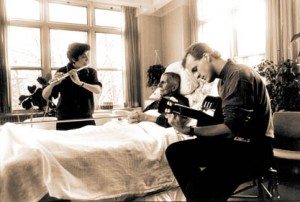Susan Poor, co-author of ‘There’s No Place Like Home: Models of Supportive Care for Elders ‘ and one of the founders of the San Francisco Village and talked to AHWGO about the ‘Village Model’ as one example of such supportive communities. The core idea of the ‘Village’ is to provide the structure of a trusted, local community to older adults. It originated in the US in Beacon Hill , Boston, has roots in Israel and other expressions in Europe such as ‘Meet-up’ in the UK. The Village idea is often linked with ‘aging in place’ since it provides some level of support for daily living that allows people to stay in their homes longer as they age, frailties develop and new needs evolve.
What are the communities we live in throughout our lives and why do many of us have to build one again as older adults? We build our communities as we grow up, through parents, school, college, work, kids. Our society is mobile, we go where opportunities are and often have to reestablish ‘home’. ‘Home’ means above all community. This starts for many young adults as a rite of passage when they leave the family home for college. They are leaving behind parents and empty nests. This is the time when the empty-nesters are reconnecting with their friends, rebuilding communities or simply never end up filling the void. In retirement some parents leave their community and move into the community of their kids. Communities they have to work on making their own. Then comes a time when kids have to take responsibility for ailing parents. With long distance parents, kids travel and have to learn about the resources of the communities their parents are living in. Parents have to become comfortable with asking for help – either from their own children who are often far away or more often from others who live in proximity. The structure of the ‘Village’ makes it o.k. for them to do so. They become members of a group that acknowledges the need for and acceptance of assistance by other members and volunteers under the guidance of the ‘Village’. They also become part of a buying club. Local vendors and service providers, vetted by the ‘Village’ commit to providing services in a way that is appropriate for older adults. Being part of a group also empowers and instills a sense of belonging and of responsibility for each other. This is a huge asset for human well being and as shown by the recently published study on ‘Social Relationships and Mortality Risk’ by Brigham Young University a major health factor for older adults.
Prof Holt-Lunstad said: “The idea that a lack of social relationships is a risk factor for death is still not widely recognized by health organizations and the public. When someone is connected to a group and feels responsibility for other people, that sense of purpose and meaning translates to taking better care of themselves and taking fewer risks.”
Community building has become an activity not just a function of where we live. Despite or maybe because of our mobility this has become more and more an active endeavor, expressed in the enormous popularity of social media and the proliferation of physical groups like the ‘Village’. We all need it – social connections.
